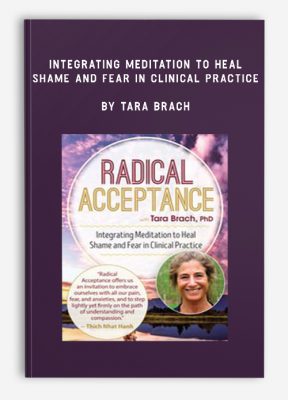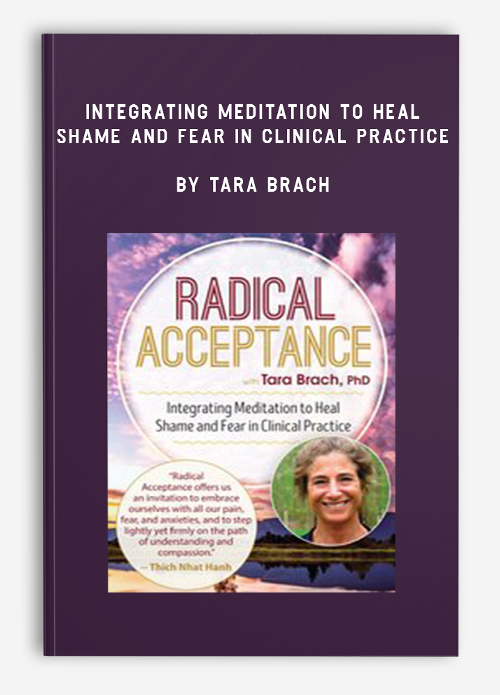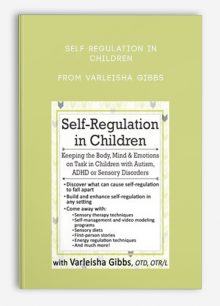Integrating Meditation to Heal Shame and Fear in Clinical Practice by Tara Brach
$219.99 $62.00

Integrating Meditation to Heal Shame and Fear in Clinical Practice by Tara Brach
**More information:
Get Integrating Meditation to Heal Shame and Fear in Clinical Practice at Salaedu.com
Description
Imagine what it would be like for your clients to be without anxiety about their imperfections. World renowned meditation teacher, clinician and best-selling author Tara Brach, Ph.D., will teach you the specific practices your clients need to become more mindful and compassionate toward the “unforgivable” parts within themselves — and how to help our clients free themselves from “the prison of shame and self-aversion”. Radical acceptance is the path to freedom your clients seek.
Tara Brach has taught clinicians around the globe how to effectively combine therapy with meditation and mindfulness to transform their practice. Therapy helps us to recognize and accept our patterns and imperfections, while meditation gradually opens us to the confidence that we have an inner refuge, a way to hold our lives in our own caring and healing presence. This is the groundwork for deeply enriching clinical practice and offering strategies to clients that increase self-trust, self-compassion, confidence, understanding and resilience.
Engage in guided meditations, experiential exercises and conversation that will teach you specific meditations to heal fear, judgement and unforgiving behaviors. Radical Acceptance is the capacity to see clearly what is happening in the moment, and accept what we see. In this workshop you will explore how the practices of mindfulness and compassion allow us to genuinely embrace our lives, and connectedness with others.
One of the deepest forms of suffering is the pain of feeling that “something is wrong with me”. The feeling of falling short, like a toxic gas we continually breathe, makes it difficult to be truly intimate with others and at home in our own body, heart and mind. Whether in the shape of chronic self-judgment, depression, anxiety or gripping shame, feelings of deficiency prevent us from living and loving fully.
Radical Acceptance and Meditation Overview
- Cause of the pervasive sense of personal deficiency in contemporary culture
- Practice – establishing intention, quieting mind, sensory awareness
- Understand the cause of emotional suffering from the perspective of
- Buddhist psychology
- Western psychology – attraction, aversion
- Evolutionary psychology- negativity bias
- Preponderance of shame in western culture
Meditation for Emotional Resilience, Emotional Intelligence and Deep Transformation
- Neuroplasticity
- Shifting from “Fight Flight Freeze” to “Attend and Befriend”
- Present centered non-judgmental attention
- Cultivate concentration and quiet mind
- Develop resource states (love, relaxation, peace, etc.)
- Counter dissociation – cultivate sensory-based attention
- Current research – efficacy of mindfulness and therapeutic healing
- Practice & Discussion: Guided exercise in embodied presence.
Radical Acceptance: Cultivate the Two Wings of Awareness
- Basic principles and components of
- Buddhist mindfulness meditation
- Role of concentration in cultivating mindfulness
- Objects of concentration (audio, kinesthetic, visual)—differential uses of objects
- Working definition of mindfulness
- Radical Acceptance: The two wings of awareness
- Practice & Discussion: The two wings – “yes” meditation
The RAIN Model: Apply Meditation to Emotional Suffering
- A model for how we get locked into shame and fear
- Transform shame and fear- pathways of reconnecting
- Introduce RAIN: recognizing, allowing, investigating, nurturing
- Introduce version of RAIN with additional resourcing
- Comprehensive case review
- Practice & Discussion: RAIN for self-compassion
Releasing Armor: Cultivate a Forgiving Heart
- Research on forgiveness
- The process of forgiving- recognizing stories, contacting vulnerability
- Need for clinical support
- Sequence of attentional strategies
- Case study
- Practice & Discussion: Classical forgiveness
Evolving our Capacity for Compassion
- The alchemy of arousing compassion
- Working with both dissociation and the tendency to get flooded
- Practice & Discussion: Compassion Meditation
Positive Neuroplasticity – “Seeing the Good”
- The gift of mirroring
- Deepening intimacy and connection- in our individual and collective psyche
- Practice & Discussion: Cultivating loving kindness
More information about Medical:
Medicine is the science and practice of establishing the diagnosis, prognosis, treatment, and prevention of disease.
Medicine encompasses a variety of health care practices evolved to maintain and restore health by the prevention and treatment of illness.
Contemporary medicine applies biomedical sciences, biomedical research, genetics, and medical technology to diagnose, treat, and prevent injury and disease,
typically through pharmaceuticals or surgery, but also through therapies as diverse as psychotherapy, external splints and traction, medical devices, biologics, and ionizing radiation, amongst others.
Medicine has been around for thousands of years, during most of which it was an art (an area of skill and knowledge) frequently having connections to the religious and
philosophical beliefs of local culture. For example, a medicine man would apply herbs and say prayers for healing, or an ancient philosopher and physician would apply bloodletting according to the theories of humorism.
In recent centuries, since the advent of modern science, most medicine has become a combination of art and science (both basic and applied, under the umbrella of medical science).
While stitching technique for sutures is an art learned through practice, the knowledge of what happens at the cellular and molecular level in the tissues being stitched arises through science.
1 review for Integrating Meditation to Heal Shame and Fear in Clinical Practice by Tara Brach
Add a review Cancel reply
Related products
HEALTH - FITNESS - LIFESTYLE - MEDICAL
HEALTH - FITNESS - LIFESTYLE - MEDICAL
HEALTH - FITNESS - LIFESTYLE - MEDICAL
HEALTH - FITNESS - LIFESTYLE - MEDICAL
HEALTH - FITNESS - LIFESTYLE - MEDICAL
HEALTH - FITNESS - LIFESTYLE - MEDICAL
HEALTH - FITNESS - LIFESTYLE - MEDICAL
Complete Certified Professional Coach Online Course from Berry Fowler










Trevis Trevis –
This is one of the most beautiful website and you can check the reviews of my website here: https://salaedu.com/clients-proof-and-reviews/